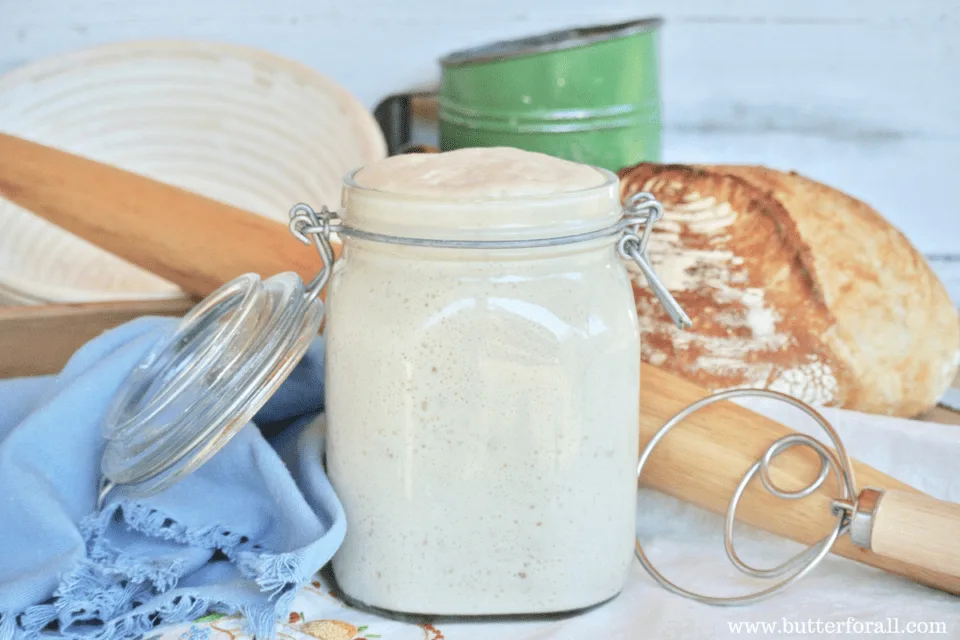I bet you can guess why I love English muffins!
Yep, all those nooks and crannies, little empty pools, perfect for catching all the melted butter!

This easy recipe ferments and rises overnight at room temperature so you awaken to a soft, manageable dough.

In the morning roll out the dough, cut out the muffins, preheat the griddle, cook these little sourdough puffers low and slow, and voilà, a beautiful butter-holding breakfast!

What Should You Eat on These Sourdough English Muffins?

If you are passionate about real food and love to make your own, try making my real Cultured Raw Butter.
For a special treat add a foraged jam or jelly like this immune-boosting Elderberry Jelly from Practical Self Reliance.
Or maybe you have some wildflowers in your yard? Try a very unique Wildflower Jam from Nitty Gritty Life.
Love the simple things in life? Me too. Nothing beats a buttery sourdough English muffin with Honey Sweetened Strawberry Jam like the one found at Texanerin Baking!
Try these muffins as the bread for an egg sandy with this delicious Pastured Pork Breakfast Sausage.
Or try them as the base for every kid’s favorite “Engamuff pizza!” Just spread each half with tomato sauce, mozzarella, and a few favorite toppings and bake at 375ºF until the cheese is golden and bubbly.
Whatever You Top Them With, These Overnight Sourdough English Muffins Are Sure to Become a Family Favorite!


Overnight Sourdough English Muffins
An easy to work with, traditional sourdough English muffin, perfect for holding a variety of toppings (like butter!)
Ingredients
- 250 grams (1 cup) sourdough starter, at 100% hydration
- 510 grams (2 cups) milk
- 600 grams (4 cups) organic bread flour
- 12 grams (2 teaspoons) salt
- 20 grams (2 tablespoons) coconut sugar, or honey
Instructions
The Night Before
- In a large bowl with plenty of room for proofing, gently mix all ingredients either by hand or in a stand mixer until a smooth sticky dough is achieved.
- Cover the bowl and let it proof at room temperature overnight, 8 to 12 hours.
The Next Morning
- With wet hands, do one series of stretch and folds around the dough in the bowl, deflating the dough, and loosely preshaping it into a ball. Wait 5 to 10 minutes before continuing.
- Generously flour your work surface.
- Turn the dough out on the floured surface and pat flour onto both sides.
- Pat or roll the dough into a 3/4-inch-thick sheet. Add more flour if you notice sticking.
- Use a large biscuit cutter to cut out as many muffins as possible. Make sure they are floured on the bottom and move them off to the side of your work surface to rest.
- Gather the remaining dough and brush off any loose flour. Shape the dough into a ball and re-roll it to 3/4-inch thickness. Cut out the muffins and set them aside. Repeat this step one more time if necessary.
- Let all the muffins rest for 30 minutes.
- Preheat a large cast-iron griddle to medium-low. Make sure it is thoroughly heated through.
- Add the muffins to the griddle with an inch of space around each. Cook them for 5 to 7 minutes per side. They should be golden to dark brown and fully puffed when done. Cool them on a wire rack before slicing.
Notes
These muffins freeze really well and defrost quickly!
For a longer fermentation, the dough can be refrigerated after the initial proofing for up to 72 hours.
Want To Learn Everything About Sourdough?
Start with this free guide:



LEAFY
Sunday 16th of March 2025
.HOW LONG DO YOU COOK ENGLISH MUFFINS AND.WHAT TEMPUTURE.?
Butter For All
Friday 21st of March 2025
Hi Leafy. Temperature is in step 8 of the recipe. Cook time is in step 9.
Angie
Wednesday 12th of February 2025
This is one of my absolute favorite sourdough recipes. Also, hear me out, BLACKSTONE!!!! I get them all done at once!!!
Butter For All
Friday 21st of March 2025
Hi Angie!
So happy that you are enjoying the recipe :) I love your recommendation! Thank you for sharing!
I never even thought about using one of these 🤯
Lulu
Wednesday 25th of December 2024
I've used a slightly altered version of your recipe for over three years, so I thought I'd better comment and thank you for posting it.
Thank you, truly. These English muffins are my actual daily bread.
My habit is to make a sponge in the evening. I reduce the flour to 400g, use molasses for sweetener and color, dried milk & water instead of whole milk, and a dollop of heavy cream for a little fat.
In the morning, I add 200-ish grams of whole wheat flour, rest the dough, then pull/fold, let rise, roll out and cut rounds or slice squares. I lay them out on a cornmeal dusted parchment, let them rise/rest a bit and finally cook them in bits of butter in two cast iron pans.
Since I make a batch every two or three weeks, I freeze them, and they toast up perfectly. Sometimes I knead raisins and cinnamon into the second roll-out. Highly recommend.
I appreciate the flexibility of this dough. If I get jammed up for time, I put the dough – or rounds/squares – in the fridge for up to 24 hours and carry on once the dough has warmed up.
Thanks again.
Butter For All
Monday 6th of January 2025
Hi Lulu!
It sounds like you have made this recipe your own. I love it. I'm so pleased I could supply a dependable base recipe :)
Your technique and additions are perfect. Well done!
Thanks so much for the thoughtful note,
Courtney
Annie Hess
Saturday 7th of December 2024
I saw your other recipe for einkorn English muffins, but would love to do an overnight fermented version, also utilizing 100% einkorn. Subbing out the bread flour for einkorn here, how would you convert this overnight recipe for that? Many thanks!
Butter For All
Thursday 12th of December 2024
Hi Annie,
I would probably go back use the einkorn formula and adapt it to an overnight recipe. The problem that I ran into with einkorn fermenting overnight at room temperature was it led to the dough being over-fermented in the morning. That weak einkorn gluten is just not strong enough to stand up to that long fermentation period. With that said, I think an overnight fermentation in the refrigerator would be perfectly acceptable. I would try mixing the dough together and letting it bulk ferment for about 4 hours at room temperature before being placed in the refrigerator for up to 12 hours.
Let me know if you have any further questions!
Robin
Sunday 7th of January 2024
Beginner sourdough baker here. I have tried loaves but have decided that bagels, EM, pretzels are more my success stories. This recipe is perfect. Like a few others that have commented, I should have rolled my dough thinner and used an actual cutter not a cup. Overall I am pleased with my attempt with this recipe and will definitely try again.
Butter For All
Wednesday 24th of January 2024
Hi Robin!
I LOVE hearing about your success! I'm wondering if you've tried my Butter Top Sandwich Loaf? This is a great loaf for beginners and like most (but not all) of my recipes it has an overnight bulk ferment that can be helpful when you have a young starter.